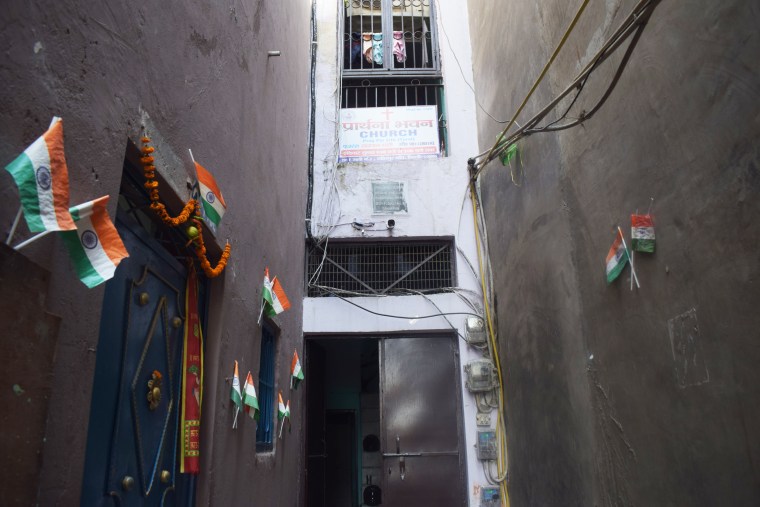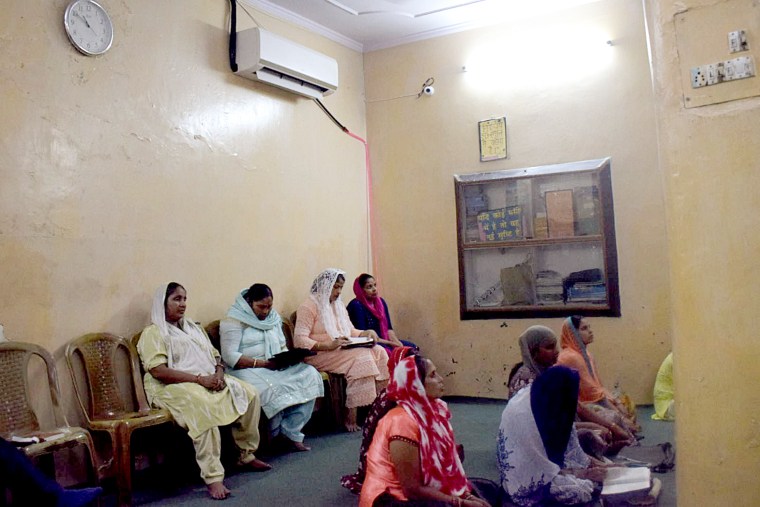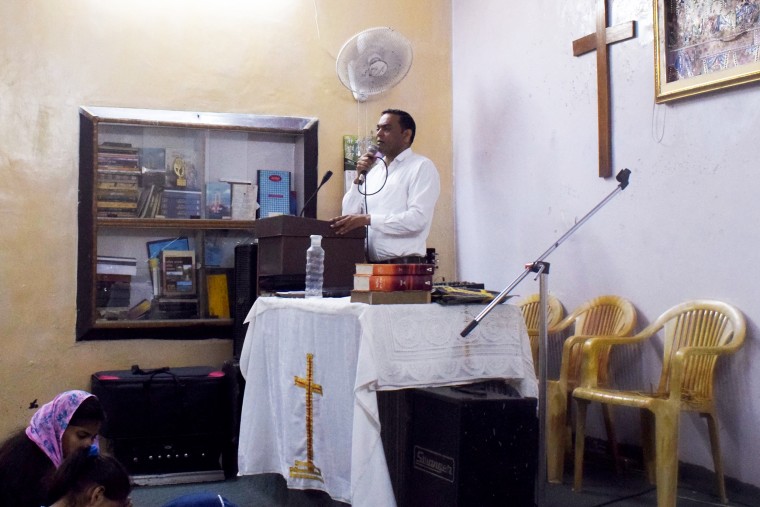NEW DELHI — Abhishek Donald was at church last month, playing the drums as usual, when he and fellow parishioners were attacked by a right-wing Hindu mob.
During the assault, a man wielding an iron rod broke the knuckles on Abhishek’s right hand and struck him on the back at least twice, turning his skin blue. His pinkie remains twisted, rendering him unable to play the drums properly.
That hasn’t stopped Abhishek, 16, from going back to church.
He was one of the few people at the Prarthana Bhawan Church in India’s capital region on Sunday, two weeks after the mob barged in.
The group of about 30 people attacked dozens of churchgoers, including women and children, the church's pastor, Satpal Bhati, said. The Aug. 20 assault on the Protestant church in northeastern Delhi took place less than 10 miles from where world leaders including President Joe Biden will meet this week for the annual summit of the Group of 20 economies.
“They came straight inside and started beating up people. They broke a chair, tore our Bible, busted the drums, and beat the kid’s hand with a rod,” Bhati said.
“They said, ‘This can’t go on, you can’t do this, this is a Hindu nation,’” he added.

Communal violence is nothing new in India, a Hindu-majority country of 1.4 billion where periodic clashes have broken out since its departing British colonial rulers partitioned the Indian subcontinent in 1947. But in recent years there has been a surge in attacks on Muslims, who make up about 14% of the population, as well as Christians, who are India’s second-largest religious minority at less than 3% of the population.
Critics say religious polarization has intensified under Prime Minister Narendra Modi and his Hindu-nationalist government, and that it is now reaching deep into the capital, which had largely managed to keep the violence at bay.
A few weeks before the church attack in Delhi, thousands of Muslims in the neighboring state of Haryana fled violence-stricken neighborhoods after seven people were killed during a religious Hindu procession organized by groups ideologically aligned with Modi’s Bharatiya Janata Party. Muslim shops and homes were targeted as the communal clashes spread from the district of Nuh to the city of Gurugram, a tech hub where multinational companies such as Google, Ernst & Young and Deloitte have offices.
New Delhi was also engulfed by sectarian riots for several days in 2020, leaving more than 30 people dead.
The United Christian Forum, a human rights group based in New Delhi, said in July that since the start of the year there had been at least 400 acts of violence against Christians across 23 states in India, the Indian news outlet The Wire reported, up from 274 in the first half of 2022.

Experts say religious violence in India is driven by a desire to establish a Hindu state, trumping the secularism enshrined in the country’s constitution and instilling fear in those who stand opposed.
“What we are witnessing in India is majoritarianism couched as democracy,” said M. Sudhir Selvaraj, a lecturer at the University of Bradford in Britain who studies anti-Christian violence in India. “There is a sense that people feel emboldened by Modi as the leader. They feel that this is ‘our’ time and ‘our’ place.”
During a visit to the White House in June, Modi denied that India had a problem with religious discrimination, saying there was “absolutely no space for discrimination” in his government. Since then, he has come under fire for his handling of deadly clashes between Hindu and Christian ethnic groups in the northeastern state of Manipur, which he said nothing about publicly for more than two months until a video spread online of two women being paraded naked by a mob.
‘They’re scared’
On Sunday, only about a dozen people sat on the carpeted floor at the Prarthana Bhawan Church, which before the attack had sometimes been packed with more than 100 churchgoers. A framed painting of the Last Supper was missing its glass.
“They trashed it,” Bhati said, “but then we tried to fix it up and put it back on the wall.”
Local police, who have been providing the church with guards since the attack, said Tuesday that one man had been arrested in connection with it.
Rock Robinson was not in the church during the attack, but it did not deter him from attending the service on Sunday.
“I’m never, ever scared,” said Robinson, 73, who has been coming to the church for almost a decade.
He expressed determination in the face of the attack, which he said was inevitable given the nationalistic Hindu fervor that has gripped the country.

“Even Jesus’s disciples were put behind bars, but then they had an opportunity to preach, preach, preach,” he said.
The pastor’s 13-year-old son, Amosh, though a bit shaken by the attack, continued playing the drums undeterred. Some of the church’s drums were held together by black tape after the mob punched holes in them.
His father read out verses from the corner of the stage, rather than his usual spot in the center. The center mic had been stolen by the mob.
“Usually 50 people stand amid us,” Bhati told his parishioners.
“Even in a time of anger, we’re still praying,” he said.
Abhishek, the injured teenager, occasionally hit a drum with his left hand.
“They’re scared,” he said of the parishioners who were not there.
But the church is like home for Abhishek, who has been going there with his family for as long as he can remember.
“We live here,” he said. “We have nowhere to go.”

